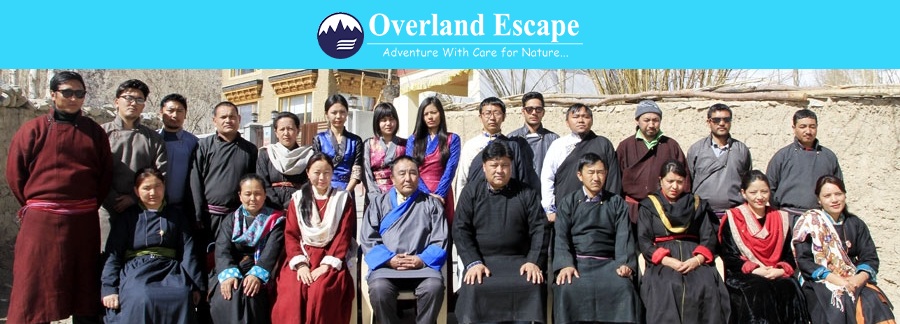Overland Escape, established in August 1999, stands as a beacon in the realm of travel companies, spearheading the marketing of Ladakh globally and within India. With a steadfast commitment to bolstering Ladakh’s economy, this pioneering enterprise collaborates diligently with partners both domestically and abroad. Since its inception, Overland Escape has fostered amicable relations and cooperation within the travel industry, crafting bespoke tour packages for Ladakh, Kashmir, Himachal, Nepal, Bhutan, and Tibet, distinguished by their competitive pricing and itineraries.
Anchored by a robust quality management system, the company champions the preservation of destination character, safeguarding diverse cultures and traditions while nurturing a profound passion for exploration. Committed to environmental stewardship, Overland Escape spearheads initiatives like the annual garbage cleaning trek, reinforcing its dedication to conservation. Embracing a philosophy of empowerment, the company prioritizes the training and employment of local personnel, enriching visitor experiences and fortifying local economies. With an unwavering focus on enhancing customer efficiency, productivity, and success, Overland Escape stands as a dependable ally, poised to elevate travel experiences and leave an indelible mark on the landscape of exploration.
During a special conversation with The Interview World, Tundup Dorjey, the Managing Director of Overland Escape at SATTE 2024, highlights his company’s dedication to offering exceptional experiences for tourists. He emphasizes the importance of policy intervention to ensure the sustainability of tourism in Ladakh. Now, let’s delve into the key insights from his interview.
Q: What unique experiences and services does your destination management company offer to travellers?
A: For more than twenty-five years, we’ve served as Ladakh’s premier destination management company (DMC). As an adventure tour specialist, we cater to adventurous souls, nature lovers, thrill-seekers, and curious explorers seeking unique, off-the-beaten-path experiences. Our repertoire includes a diverse array of activities: trekking, mountaineering, white water rafting, wildlife safaris, jeep expeditions, mountain biking, spiritual journeys, cultural immersions, educational excursions, community-based tourism, leisurely holidays, and more—all perfectly tailored to Ladakh’s pristine ecosystem.
In Ladakh, we excel in delivering value-added services and unforgettable experiences to travellers. Through meticulously crafted venue-specific packages, we ensure that every encounter leaves a lasting impression on our guests.
Q: What is the annual number of foreign tourists visiting Ladakh?
A: Our focus isn’t limited to any particular market or foreign country; rather, we cater to both domestic and international tourists alike. Throughout peak seasons, our destination attracts a substantial influx, typically ranging between 380,000 to 400,000 tourists. Among this vibrant crowd, a notable proportion consists of approximately 85,000 to 90,000 foreign visitors, highlighting the diverse appeal and global recognition of our location. This mix of domestic and international tourists adds vibrancy to our tourism landscape, fostering cultural exchange and economic growth while enriching the overall experience for all who visit our destination.
Q: What’s the best time in a year to visit Ladakh?
A: The prime time to experience Ladakh’s awe-inspiring beauty is nestled within the summer months, spanning from May through September. During this period, the weather is pleasantly mild, and the region’s roads become more accessible, facilitating seamless exploration. As October approaches, the season gracefully transitions to its end. These months offer the gift of clear skies, unveiling the majestic Himalayas in all their glory, creating an ideal backdrop for a plethora of outdoor adventures, including trekking and sightseeing.
Moreover, cultural festivities such as the Hemis Festival in July and the Ladakh Festival in September infuse the air with vibrancy, adding a deeper layer of cultural richness to the journey. However, given Ladakh’s popularity among tourists during this peak season, meticulous planning becomes imperative to ensure a smooth and fulfilling experience amidst the region’s bustling tourist scene. Embracing Ladakh during its summer splendor promises unforgettable memories and unparalleled experiences amidst its breathtaking landscapes and vibrant culture.
Q: What are the available hospitality amenities and infrastructure in Ladakh catering to tourists?
A: Recently, domestic tourism has surged, particularly in Ladakh, which was previously renowned for adventurous tourism. Adventurous travellers typically eschewed hotels, opting instead to stay in camps near their preferred spots. However, since the late nineties, following the Kargil war, Ladakh gained attention from domestic tourists. This newfound interest was further fuelled by the portrayal of Ladakh’s natural beauty in the movie “3 Idiots,” including its iconic Pangong Tso Lake.
Consequently, as families began to explore Ladakh, the need for hotels arose. Hotels became an integral part of the domestic tourist experience, prompting the development of various categories, including 3-star, 4-star, and 5-star accommodations. Alongside lodging, transportation infrastructure also saw significant improvements, solidifying hotels and transportation as vital components of Ladakh’s tourism industry.
Q: How has the tourism sector in Ladakh changed visibly since the abrogation of Article 370?
A: Following the abrogation of Article 370, Ladakh underwent a significant geographic transformation, transitioning from being a district in Jammu & Kashmir to becoming an independent Union Territory of India. This shift is akin to moving from a district status to that of a state. Consequently, funds have begun flowing into Ladakh to support its developmental initiatives. However, the onset of the COVID-19 pandemic disrupted this development trajectory, causing numerous projects to come to a standstill. Moreover, restrictions on both domestic and international travel due to the pandemic adversely affected the tourism sector in Ladakh. Consequently, in terms of overall impact, the difference isn’t quite evident. Nonetheless, there have been signs of improvement in the situation there.
Q: How are the government and local communities working together to maintain Ladakh’s ecological integrity and sustainability in the face of increasing adventure tourism?
A: Ladakh’s carrying capacity is quite limited, and its environment is extremely fragile. The region isn’t equipped to handle a large influx of tourists. Consequently, restrictions are now being imposed on the locals themselves. Recently, Memorandums of Understanding (MoUs) have been signed between hotel associations and travel agency associations, urging locals to refrain from constructing large hotels. Ideally, hotels should have no more than 20 to 30 rooms.
There’s a growing prioritization of environmental concerns over tourism. Both locals and tourism activities are being subjected to restrictions. Given the abundance of hotels already present, further hotel development is unnecessary. In areas like Pangong and Leh, there’s already an overabundance of hotels. To ensure the sustainable development of tourism in Ladakh, stringent regulations are imperative. Without proper oversight, the region risks facing severe water shortages if tourism is allowed to expand indiscriminately.










27 Comments
Thanks for sharing. I read many of your blog posts, cool, your blog is very good.
Throughout the awesome design of things you actually receive an A+ for hard work. Where exactly you actually confused me was in the specifics. You know, they say, the devil is in the details… And it could not be much more true at this point. Having said that, permit me inform you just what exactly did deliver the results. The text is actually incredibly persuasive which is probably why I am taking the effort to opine. I do not really make it a regular habit of doing that. Next, despite the fact that I can certainly notice the jumps in reason you make, I am not necessarily convinced of just how you seem to unite the ideas which inturn help to make your final result. For now I will subscribe to your issue however hope in the foreseeable future you actually link the dots better.
I do agree with all of the ideas you’ve presented for your post. They’re really convincing and will definitely work. Nonetheless, the posts are too quick for starters. Could you please extend them a bit from subsequent time? Thanks for the post.
I am really inspired along with your writing skills and also with the layout in your weblog. Is this a paid subject matter or did you customize it yourself? Anyway keep up the nice quality writing, it’s uncommon to peer a great blog like this one nowadays..
Thank you for sharing excellent informations. Your site is so cool. I’m impressed by the details that you?¦ve on this site. It reveals how nicely you perceive this subject. Bookmarked this website page, will come back for extra articles. You, my friend, ROCK! I found simply the information I already searched all over the place and simply couldn’t come across. What a great website.
I’m not sure where you’re getting your information, but great topic. I needs to spend some time learning much more or understanding more. Thanks for great information I was looking for this info for my mission.
After study a couple of of the blog posts in your web site now, and I really like your manner of blogging. I bookmarked it to my bookmark website record and will likely be checking again soon. Pls check out my site as effectively and let me know what you think.
Its such as you learn my mind! You seem to understand so much approximately this, like you wrote the book in it or something. I feel that you simply can do with a few percent to pressure the message house a little bit, however other than that, that is magnificent blog. A great read. I’ll certainly be back.
I precisely wanted to thank you very much once more. I am not sure the things that I would have made to happen in the absence of the type of advice documented by you concerning that concern. It actually was a very distressing issue for me personally, but looking at your specialised avenue you processed that made me to cry for happiness. I am thankful for the information and thus sincerely hope you realize what an amazing job you are undertaking teaching the mediocre ones thru your website. I am sure you haven’t got to know any of us.
I have read a few good stuff here. Definitely worth bookmarking for revisiting. I wonder how much effort you put to create such a fantastic informative web site.
Everything is very open and very clear explanation of issues. was truly information. Your website is very useful. Thanks for sharing.
Rattling clear site, regards for this post.
I dugg some of you post as I thought they were very beneficial very beneficial
Your place is valueble for me. Thanks!…
Well I really liked studying it. This subject procured by you is very helpful for correct planning.
obviously like your web-site but you need to check the spelling on quite a few of your posts. Many of them are rife with spelling problems and I find it very troublesome to tell the truth nevertheless I’ll surely come back again.
As a Newbie, I am permanently browsing online for articles that can benefit me. Thank you
I am also writing to let you understand of the exceptional discovery my girl went through using your web page. She noticed many issues, including what it’s like to have an excellent coaching mood to make the mediocre ones just understand several tricky topics. You truly did more than our expectations. I appreciate you for imparting such helpful, safe, informative and in addition easy thoughts on your topic to Tanya.
You can definitely see your expertise in the work you write. The world hopes for even more passionate writers like you who are not afraid to say how they believe. Always go after your heart.
Good – I should certainly pronounce, impressed with your website. I had no trouble navigating through all the tabs and related info ended up being truly easy to do to access. I recently found what I hoped for before you know it at all. Quite unusual. Is likely to appreciate it for those who add forums or something, site theme . a tones way for your customer to communicate. Nice task..
WONDERFUL Post.thanks for share..more wait .. …
Whats up! I simply want to give a huge thumbs up for the nice info you have right here on this post. I will likely be coming back to your blog for more soon.
You are my aspiration, I own few blogs and occasionally run out from post :). “Actions lie louder than words.” by Carolyn Wells.
Very interesting topic, thankyou for putting up.
Would love to always get updated outstanding web site! .
Hey there! This is my first visit to your blog! We are a group of volunteers and starting a new project in a community in the same niche. Your blog provided us useful information to work on. You have done a marvellous job!
Regulations are crucial for sustainable tourism in Ladakh, as they help preserve the region’s delicate ecosystem while supporting local communities. Just as actors like Omari Hardwick maintain balance in their personal and professional lives, Ladakh’s tourism must find a balance between economic growth and environmental preservation for lasting success.
Comments are closed.